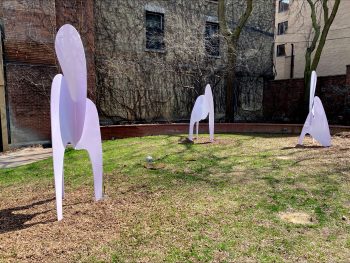
Since opening in 1981, the Toronto Sculpture Garden (TSG) commissioned temporary artworks by over 80 artists in a small City of Toronto park opposite St. James Cathedral on King Street East. Until 2014, it was operated as a partnership between the City of Toronto and the Louis L. Odette Family, benefactors who created the non-profit L.L.O. Sculpture Garden Foundation which funded and administered the exhibitions. Under the direction of Rina Greer, the TSG allowed artists to explore issues of scale and materials, as well as engage with the local community and visitors to the neighbourhood. For some, the expansion of their practice beyond the studio led to major public artworks elsewhere.
The TSG is now managed by the City of Toronto and acts as a stepping stone between studio work and public art, providing artists with the opportunity to work experimentally in public space. Exhibitions change twice per year, typically in the spring and fall.
April 24 to October 13

The Keepers emerge from an alternative evolutionary branch, their forms shaped through a synthetic genetic algorithm. The algorithm originates with three distinct parent groups—genderless, diverse and unconstrained by traditional hierarchies. Standing six to seven feet tall, the Keepers appear as otherworldly sentinels—gentle guardians watching over their surroundings. Their polished aluminum bodies mirror the shifting hues of the garden, adapting to their surroundings like living entities. Though alien in form, they emanate an empathetic presence, offering safety in their quiet network of protection.
Mads Brimble is a contemporary artist based in Toronto, Canada. Brimble delves into the use of technology and creative coding to produce tangible sculptural artworks. Her work manifests as a series of sculptures representing organisms from alternate worlds, blending traditional and digital processes to imagine new possibilities for life and being. Brimble’s artistic practice explores speculative evolution, genetics and processes of change with a specific focus on challenging societal norms and assumptions that are often reinforced through biological discourses.
The TSG is located at 115 King Street East, just east of Church Street, directly across the street from St. James Cathedral and between two of the oldest buildings in the city, dating from the 1840s.
The park is approximately 80′ by 100′ (25m x 30m). With its proximity to King Street to the north and the St. Lawrence market neighbourhood to the south, the park serves a wide variety of users, from those who live and work in the area to visitors to the neighbourhood and the City, people of all ages, those seeking out art and those coming across it by accident.
9 a.m. to 9 p.m. daily